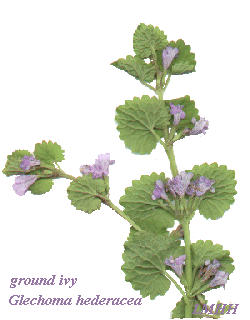
Also called "ground ivy" , "Gill-over-the-ground" or "Gill o'er-the-ground" This little plant can be a neusance, but it is sort of attractive. Especially so since it comes up quite early in our area when you are really hoping for a bit of color no matter how small! It has small "ruffely", round kidney shaped , dark green, a bit hairy leaves growing opposit each other on a square stem. At the base of the leaves, tiny deep throated purple or blue blooms appear that, to me, resemble tiny sweet pea blooms.
The plant is a perennial and also reseeds itself readily. Breaking up the roots, like some grasses, make it spread more rapidly. Like I say, it can get to be a neusance.
The scent is a bit strong and on the bitter side, kind of like camphor. They bloom in late spring and can be dried for use as a spring tonic. Said to be helpful to treat symptoms of colds, pain associated with PMS and kidney irritations. Usually about a cup of the tea taken 3 times a day is said to be effective. Don't continue any treatment indefinitely, however. If problems persist over a couple of days, you may need to consult a professional practitioner.
I find myself quite confused, however, as I, having heard that this plant was also called Hen-bit, looked up Hen=bit and found several articals and photoes of Henbit (Lamium amplexicaule) noted as a mint cousin common in gardens in the eastern half of the United States and a number of photoes, some exactly like Ale-hoof.
Also, in Missouri and Texas, many people see ground ivey as little plant growing similiarly to above plants but with shiney round, beautifully green leaves, generally low and growing in cool damp areas. It, too,is very invsive and usually not wanted,even though it is quite pretty.
|



